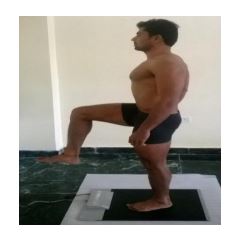PRESSURE ANALYSIS OF THE DOMINANT FOOT AND NON DOMINANT FOOT OF VOLLEYBALL PLAYERS
Abstract
Analyzing foot pressure is helpful in clinical diagnosis. Possible applications include the diagnosis of back injuries, prevention of diabetic foot ulceration, and adaptation of insoles for orthopedic applications. Consequently, several approaches to measure foot pressure distributions exist. Most people pay little attention to their feet, feet have to withstand physical strain occurring when standing for hours, carrying heavy objects, or moving rapidly during sports. In volleyball player’s take off and landing plays a great role during spiking and blocking, so by knowing the bilateral difference in application of pressure and oscillation we may know about their status of joints and also prevent it from injury. Ten male Inter University right handed volleyball players of LNIPE, Gwalior were selected as subjects for the study by employing purposive sampling. Players were asked to stand on Baropodometric Platform BTS with dominant foot and non dominant foot with a gap of 3 minutes in between so that fatigue will not affect the oscillation. Initially tested lower limb was alternated between right and left in a consecutive fashion. Data obtained from the Baropodometric Platform BTS were converted to Microsoft Excel, where the following parameters were analyzed i.e. anteroposterior oscillation (APO) and mediolateral oscillation (LO) directions, the Average speed of oscillation and displacement of Center of Pressure (COP) Descriptive statistics and T-test were used for the comparison in dominant foot and non dominant foot of volleyball players at 0.05 level of significance. The dominant foot also showed less oscillation in both aspect anterior posterior oscillation and lateral oscillation which shows more joint stability and also tells about the better functioning of propiroceptors ability. May be due to more laxity in joints of non dominant foot the speed of oscillation also showed significantly higher than dominant foot causes greater displacement in center of pressure.
Downloads
References
Sonia Kanwar, Gender barriers in relation to sports participation: specific emphasis on female, International Journal of Behavioral Social and Movement Sciences, Vol.04,July2015,Issue03,p88
Fitzgerald JE, Murray A, Elliott C, Birchall JP. Comparison of body sway analysis techniques: Assessment with subjects standing on a stable surface. Acta Otolaryngol 1994;114:115-9
Harrison EL, Duenkel N, Dunlop R, Russell G. Evaluation of single-leg standing following anterior cruciate ligament surgery and rehabilitation. Phys Ther 1994; 74:245-52.
Henriksson M, Ledin T, Good L. Postural control after anterior cruciate ligament reconstruction and functional rehabilitation. Am J Sports Med 2001; 29:359-66.
Johansson H, Sjolander, P, Sojka P. Receptors in the knee joint ligaments and their role in the biomechanics of the joint. Crit Rev Biomed Eng 1991; 18:341-68.
Kollegger H, Baumgartner C, Wöber C, Oder W, Deecke L. Spontaneous body sway as a function of sex, age, and vision: posturographic study in 30 healthy adults. Eur Neurol 1992; 32:253-9.
Shafqit Hussain Shah, Physiological factors and performance gain through high altitude training, International Journal of Behavioral Social and Movement Sciences, Vol.04,July2015,Issue03,p1- 6
Winter DA. Human balance and posture control during standing and walking. Gait Posture 1995; 3:193-214.
Williams GN, Chmielwski T, Rudolph KS, Buchanan TS. Dynamic knee stability: current theory and implications for clinicians and scientists. J Orthop Sports Phys Ther 2001; 31:546-66. Zätterström R, Fridén T, Lindstrand A, Moritz U. The effect of physiotherapy on standing balance in chronic anterior cruciate ligament. Am J Sports Med 1994; 22:531-6.















